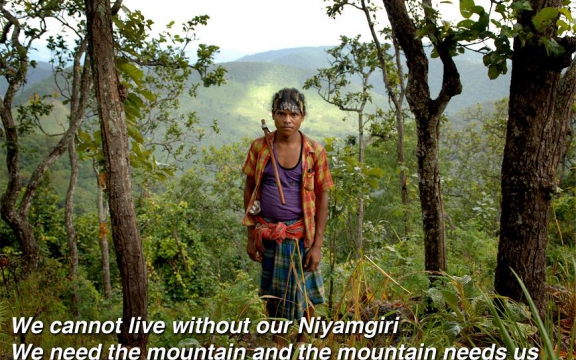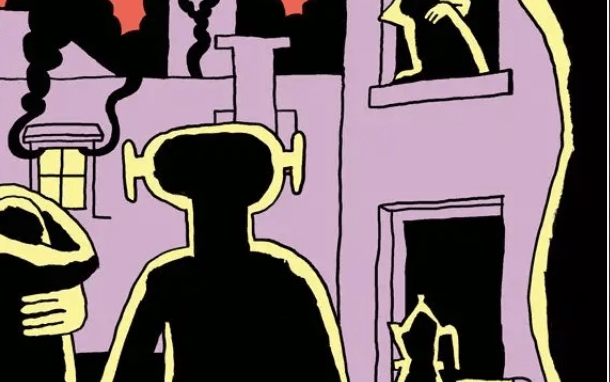In
our series on contagious alternatives, concrete utopias, paradigmatic cases,
positive news, actions to learn from, small revolutions or revolutions in
reverse, here an Indian Avatar (see pictures underneath!)… A fairytale for
activists, an example to feed upon concerning this most urgent of issues: the defense of the commons…
by Ranjani Balasubramanian
In the dense
forested heartland of India is the state of Odisha. Extending from the
beautiful Eastern coast of India along the Bay of Bengal, into the western edge
of the Deccan Plateau, the recorded history of civilization in the state spans
over 5000 years, and yet it is home to some of the most stunning and untouched
landscapes both along the sea and in pristine inland forests. The hills of
Odisha, since time immemorial, have been home to the adivasis (the first
dwellers), who are believed to predate even Vedic culture and society. Literary
works as old as the Mahabharata refer to the tribes as sovereign communities of
the forest.
Being proud and
ferocious people, they have always defended their life and land. Hindu society
reacted to their otherness by often casting the adivasis as forest dwelling
animists, while at the same time, leaving the regions inhabited by them largely
outside the rule of the regency to be managed by their own indigenous forms of
self-governance. They have thus continued through the millennia to live outside
of the structured mainstream society by developing a convivial nomadic life in
the hills and forests of India.
The Dongaria
Kondhs are one of the many Odisha tribes; a population of 8000 people who
inhabit the slopes of the Niyamgiri hill range along the western border of the
state. Niyamgiri is an area of densely forested hills, deep gorges and
cascading streams. The Dongria Kondhs farm the hills’ fertile slopes, harvest
their produce, and worship a living mountain god Niyam Raja and the hills he
presides over, including the 4,000 meter ‘Mountain of the Law’, Niyam Dongar[1].
Dharanima, the
earth goddess is also worshipped as a complement to the God of the Mountains and
it is believed that these male and female principles come together to grant the
Kondhs prosperity, fertility and health[2].
Their belief in the sacredness of the hills is rooted in a strong dependence on
the natural resources that the mountains provide. The Dongaria Kondhs are proud
of their economic independence and freedom from want.
Culturally and
ecologically the Niyamgiri hills are extremely rich and diverse. Niyam Dhongra
is the water source for both the Vasandhara River and a major tributary of the
River Nagavalli. The fauna includes a number of rare species of plants and
medicinal herbs. The forests of the Dongaria Kondhs are home to a number of
endangered wildlife species like tigers, sloth bears, giant squirrels,
leopards, langur, sambhar and mouse deer. It is also the territory of the Royal
Bengal Tiger and a migratory corridor for elephants[3]
and has been proposed as a wildlife sanctuary in 1998 by the Indian Ministry of
Environment and Forests.
These pristine
hills however have one more secret. Under this magnificent surface are huge
deposits of high grade bauxite- the raw material used to produce aluminum.
Odisha is a state that is bestowed with huge mineral deposits and since the
liberalization of the Indian economy in the 90’s, the extractive industry has
been closing in on the ecologically fragile state. The Odisha government, keen
to cash in on this bounty, has been promoting resource intensive development
models in the state.
In 2004, in
spite of the the human and ecological circumstances, the Odisha government
signed an agreement with Vedanta Aluminia, a multinational mining corporation
ironically named after a Hindu school of philosophy which emphasizes the unity
of all forms of life, to mine bauxite in the Niyamgiri hills. This would be complemented
by setting up an aluminum refinery at the foothills. To support this agreement,
large tracts of agricultural land were usurped from the tribes at the foothills
and an aluminum refinery was already set up at Lanjigarh[4].
The proposal for the open cast bauxite mine on the top of the Niyamgiri hills
was especially harsh to the tribes, for, according to their cultural and
religious beliefs the hilltop was the abode of their living God Niyamraja. As
often is the case their religious belief tied in with a very crucial ecological
aspect that the mountaintop was the source of water for the whole region.
Fuelled by this
assault on their home and religion, the Dongaria Kondhs took up massive
protests against Vedanta steel. Joined by activists and NGO’s they went to the
judiciary for relief. To understand the rest of this story, we must make a
small digression to explain the constitutional and legal position of the forest
dwelling tribal peoples in India.
Tribal people
constitute 8.61% of the total population of the country, numbering 104.28
million (2011 Census) and cover about 15% of the country’s area[5] (scattered
across the country and forming thousands of different tribes each with unique
cultures). In spite of this large presence, their interests have been often
undermined or altogether neglected.
In historical
India, the tribal peoples have always been recognized as sovereign. Even while
the forests were under the domain of the local rulers, the rights of the tribes
to the forests were always granted. However the British occupation, prompted by
the global demand for timber, regularized land ownership and asserted colonial claim
over the forests while criminalizing the traditional resource management
systems. This policy was most devastating to the tribal population, who were
restricted from free access to the forests, leading to over two centuries of
oppression and exploitation of tribal people.
During the
post-independence consolidation of the Princely States into the Republic of
India, under the land reforms, feudal and royal lands were proclaimed as
reserve forests, but the issue of tribal land rights was not addressed- an
oversight that led to numerous land conflicts between the non-tribal and tribal
populations[6].
One of the
colonial features of the independent Indian State was its imposition of
techno-scientific expertise over people’s traditional knowledge and management
systems as the only way to achieve its national development goals. Therefore,
even up until the 1990s the restrictions on the tribal access to land not only
continued but were exacerbated by laws such as The Wildlife Protection Act
1972.
After decades of
struggle for tribal rights starting with tribes from central India snowballed
into a national movement for tribal rights, the issues were brought up under
the review of the Indian judiciary in a number of litigations. The Supreme
Court of India in the first years of 2000, ruling in an important case of
evictions held that the tribes “have a definite right over the forest”[7] and
that diversions or evictions should be undertaken only with their consent.
This landmark
case led the Government of India to admit to the need to address a ‘historical
injustice’ against the forest dwellers of the country[8].
In 2006 the Forest Rights Act[9]
was passed which brought sweeping recognition and support for the forest
dwellers and their rights to the forest. However, the most significant aspect
of the bill was that the final authority for diversion of forestland for
non-forest use rested with the Gram Sabha. The gram sabha, or village council
in this case consisted of every member of the village unit, as opposed to a
council of representatives. Thus, the forest dwellers were given the direct democratic
authority to decide the future of their forests.
It is important
to know this legal history because in India, time and again, the cause of the
commons has been able to gain a foothold only because of the backing of the
judiciary[10].
In terms of social justice and progressive reforms, the Indian judiciary has
often been an under-recognized superhero.
Back in the
Niyamgiri hills, the tribe faced the full might and corruption of the State Government
and Vedanta Alumina while protesting vehemently against the destruction of
Niyamgiri. The protests gathered national and international campaigners and
were even endorsed as the real version of James Cameron’s Avatar. The
protracted legal battle raged on in the courts even as Vedanta strong-armed
their way ahead with construction of roads and access routes to the hills,
without waiting for any sort of environmental clearance. This led to a number
of violent clashes between the Kondhas and the police. When these blatant
misrepresentations and illegalities were brought to light, the Ministry of
Environment was under enormous public pressure and had to stall the
environmental clearance of Vedanta.
After nearly a
decade of resistance, in a landmark ruling in January 2014, the Supreme Court
of India rejected an appeal to allow Vedanta Resources to mine the Niyamgiri
hills. In a complex judgment, the court decreed that those most affected by the
proposed mine should have a decisive say in whether or not it goes ahead. As
per the fundamental provisions The Right to Religious Freedom, the Court
recognized that the Dongria Kondh’s right to worship their sacred mountain must
be ‘protected and preserved’, and that those with religious and cultural rights
must be heard in the decision-making process. The tribe was given three months
to decide whether to allow the mining of their sacred hills. The ruling, for
the first time in India, forced a multi-billion dollar corporation to go to each
of the twelve Gram Sabhas (village councils) of about 1500 forest dwellers, and
put forward their pleas to undertake mining in the form of a referendum
overseen by the Supreme Court of India.
In spite of
months of incitement, violence, intimidation and pressure exerted on the tribe
by the government and by Vedanta before the referandum, all 12 tribal councils
unanimously voted against the mining bid. The final say lay with the Ministry
of Environment and Forests who proceeded to nullify the mining rights of
Vedanta in the Niyamgiri hills[11].
In May 2014
Vedanta officially announced that: “In deference to the sentiments of the
community, Vedanta confirms it is not seeking to source bauxite from Niyamgiri
bauxite deposit for its alumina refinery operations, and will not do so until
we have the consent of the local communities.”[12] Victory
for the First Dwellers!
But….the
aluminum refinery however remains operational and works on the capacity of the
local Niyamgiri mine and in August 2014 Vedanta has sought permission to expand
the facility. As of 2014 the state of Odisha still has over 300 applications[13]
for mineral extraction waiting to be cleared- and unfortunately to extract
these minerals whole ecologies also need to be cleared.
Ranjani
Balasubramanian is an architect from
India, who did a postgraduate master on human
settlements at the Department of architecture in Leuven. She did a thesis on
urban activism in Bangalore in the series ‘towards an Atlas of the commons’
with a certain prof. Lieven De Cauter. Her masterthesis for the MAHS-MAUSP program
can be downloaded: soon…
[1] The word for
mountain translates as ‘Dongar’- from which the Dongaria Kondh receives their
name- the people of the mountains.
[2] ‘Report of
the four member committee for investigation into the proposal submitted by the
Orissa Mining Company for bauxite mining in Niyamgiri’, dated August 16, 2010,
by Dr N C Saxena, Dr S Parasuraman, Dr Promode Kant, Dr Amita Baviskar.
Submitted to the Ministry of Environment & Forests, Government of India.
[3] Geetanjoy Sahu,
‘Mining in the Niyamgiri Hills and Tribal Rights’, 2008
[4] It was
later discovered that the refinery was set up even before the clearances was
made and it was in blatant violation of environmental norms.
[6] Sanjoy
Patnaik ‘Rights Against All Odds: How Sacrosanct is Tribal Forest Rights?’
[7] Ibid.
[8] Ibid.
[9] The
Scheduled Tribes and Other Traditional Forest Dwellers (Recognition of Forest
Rights) Act, 2006
[10] On the crucial role the law can play in the defense of the commons,
see Peter Linebaugh’s seminal book, The Magna
Carta Manifesto, Liberties and commons
for all. University of California
Press, 2008. He proves that attached to Magna
Carta (1215) there was the ‘Charter of the Forest’, that was the foundation of
the entire idea of legal rights to the use of the forest as natural commons. Crucial
really. The law is not necessarily on the side of private property, as anarchists
and Marxists claim, on the contrary rather: the law is the foundation, the
ultimate defence of the common. Magna Carta is really a law as social contract
between the sovereign and the commoners [editor’s note, LDC]
[11] http://www.survivalinternational.org/tribes/dongria
[12] Siddhartha
P Saikia, ‘Govt rejects Vedanta’s Niyamgiri mining project’ published in
Business Line, January 12, 2014
[13] Business Standard,
‘Odisha sitting over 300 PL bids for bauxite mining’, July 25, 2014


 “Franse kernenergie? Ongelooflijk dat hun leugencam...
“Franse kernenergie? Ongelooflijk dat hun leugencam... 











